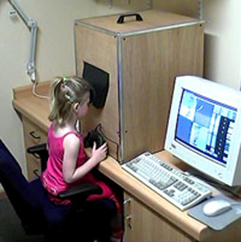Development of the I-BiT System
Earlier Studies

The original research prototype was constructed in-house and consisted of a desk top viewer linked to a PC. The PC had a standard monitor for the clinician and a stereo viewer for the patient. The child played the game using a joystick or watched video clips.
The basic concept of the I-BiT system is that the lazy, amblyopic eye is stimulated more than the good eye and when the child looks through the viewer at the game or video the lazy eye is encouraged to work.
Pilot studies were carried out at Nottingham and Glasgow and showed encouraging results.
The main findings from the studies were:
- Children enjoyed the treatment
- Vision improved dramatically in some cases (improvements ranged from 2 to 20 letters, half a line to five lines on the vision test)
- Not every child responded to the treatment and further studies are needed to identify those children most suitable for the treatment
- Vision gains have been maintained for those children reviewed at one year after treatment
The published research paper can be found here detailing the results.
New I-BiT Plus Study
Through the last decade, virtual reality display systems have become lighter, smaller, faster and more easily delivered using off-the-shelf computer equipment. This led us to develop the I-BiT Plus system which uses shutter glasses instead of a desk-mounted viewer.
A grant from the NIHR (National Institute for Health Research) has allowed us to develop new software in the form of 6 new and improved games as well as software which blurs part of the image to the good eye whilst watching a DVD or programme.
We have also upgraded the hardware and the system is now much more streamlined, so as to be used more easily at home. We hope that, by delivering the treatment at home, we can achieve longer treatment times in a shorter timescale so as to maximise the effect.
The new system consists of:
- A 27 inch HD monitor screen
- A personal computer
- An eye tracker bar
- Shutter glasses (3-D glasses)
- Controller (choice of Nintendo (NES), X-Box or tablet style).
The new games are:
- Attack of the Drones (based on Space Invaders)
- Duck Dash (where the player is a character running through a scene collecting stars)
- Head Banger (A first person full stereo version of Duck Dash)
- Critter Clobber (based on the arcade game 'Whac-a-Mole')
- Nux (an update of the game used in the old system; the player is a space craft and must avoid asteroids and collect coins)
- Chomper (based on Pacman)
- Pop (the player must pop balloons by accurately looking at them)
- Penguin Fisher (A full stereo game in which players only see the target if they have the ability to fuse the targets.)
- We have also programmed into the system episodes of Balamory, Gigglebiz, Justin's House and Something Special, as well as the facility for the child to watch their own DVD's.
The system will be loaned to patients to use at home for a set period of time and the results, alongside regular clinical assessments at the hospital, will be analysed.